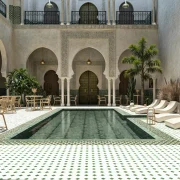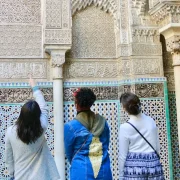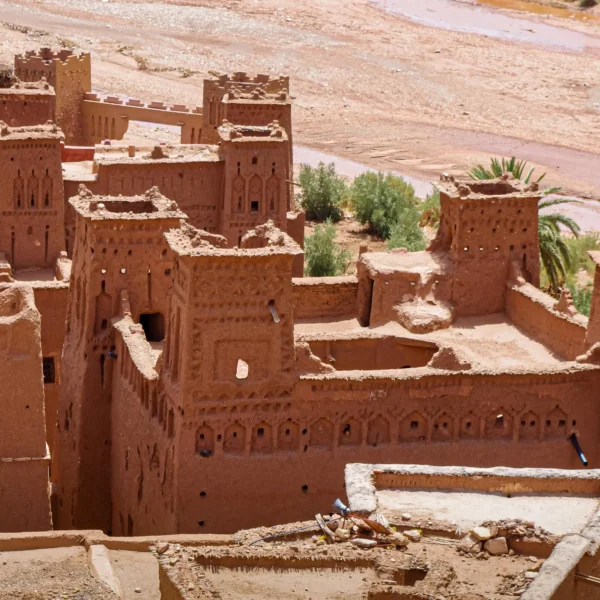
Exquisite Moroccan Restaurant: A Culinary Adventure Awaits You
Table of Contents
ToggleImagine stepping into a bustling Marrakech market to experience the pure taste of the Moroccan Restaurant at sunset, the sky painted with vibrant hues of orange and pink. The air is thick with the intoxicating scent of cumin, saffron, and slow-cooked lamb. A vendor hands you a steaming glass of mint tea, its sweetness dancing on your tongue. This is Morocco—a land where food isn’t just nourishment; it’s an experience, a celebration, a deep reflection of culture, tradition, and community.
Now, what if I told you that you could step into a Moroccan restaurant and transport yourself to this very moment? To the colors, the spices, and the warmth of the people? The world of Moroccan cuisine is waiting for you to dive in, and Moroccan restaurants are the perfect gateway to an unforgettable culinary journey. So, buckle up as we explore the world of Moroccan restaurants—what makes them so magical, what to expect, and how you can fully immerse yourself in this vibrant culture through food.
The Heart of Moroccan Cuisine: Tradition, Family, and Community
One of the first things you’ll notice when you enter a Moroccan restaurant is the warm, welcoming ambiance. It feels like stepping into someone’s home—there’s a sense of togetherness, a sense of belonging. And that’s because, for Moroccans, food is never just about eating; it’s about sharing, celebrating, and bonding.
“In Morocco, food is not just a meal, it’s a ceremony.”
— Local Proverb
Take, for example, the famous tagine. A slow-cooked stew made with meat, vegetables, and a symphony of spices, it’s not just a dish; it’s an event. The name itself comes from the unique clay pot it’s cooked in, and it’s traditionally prepared for hours, allowing the flavors to meld together. Sitting around a tagine with friends or family, dipping freshly baked khobz (Moroccan bread) into the flavorful stew, is an experience that’s both deeply satisfying and a celebration of life.

What Makes Moroccan Cuisine So Unique?
So, what is it that makes Moroccan food stand out from other cuisines? It’s the perfect blend of flavors and the way these flavors tell a story. A Moroccan dish is like a piece of history; each bite carries the legacy of centuries-old traditions, spices from distant lands, and a culture that has been shaped by Berber, Arab, and Mediterranean influences.
The Magic of Moroccan Spices
Moroccan food is known for its bold flavors, but it’s not about heat. Forget about the burning sensation of chili peppers—Moroccan dishes are about depth, warmth, and complexity. One of the key reasons Moroccan cuisine is so beloved is because of its spices, each one playing its part in the symphony of flavors.
For example, ras el hanout, a spice blend with over 20 ingredients, is often used as the “secret weapon” in many dishes. It’s a combination of aromatic spices like cumin, cinnamon, ginger, and cardamom, creating a perfect balance between sweet, spicy, and savory. Then there’s the unmistakable aroma of saffron, the world’s most expensive spice, which gives Moroccan dishes their signature golden hue and delicate flavor.
The Importance of Community in Moroccan Dining
When you sit down for a meal in a Moroccan restaurant, you’re not just there to eat—you’re there to be a part of a community. Dining in Morocco is a social experience, a celebration of togetherness. Traditional Moroccan meals are usually served family-style, where everyone shares from a communal platter. This reflects the Moroccan value of hospitality and the importance of family and friendship.
“Food tastes better when shared with others.”
— Moroccan Saying
Whether it’s a steaming pot of couscous on a Friday afternoon or a platter of pastilla (a flaky pastry stuffed with pigeon meat and almonds), the joy is in the sharing. And in Moroccan culture, food brings people together. If you’re dining at a Moroccan restaurant, don’t be surprised if someone encourages you to try a little bit of everything. After all, sharing food is a symbol of trust and connection in Moroccan society.
Signature Moroccan Dishes You Absolutely Have to Try
Now that you know why Moroccan food is so special, let’s take a deeper dive into some of the most iconic dishes you’ll find at any Moroccan restaurant.
Tagine: The Heart of Moroccan Cuisine
There’s no dish more iconic than tagine. It’s not just the name of the dish but also the clay pot in which it’s cooked. The beauty of tagine lies in the slow cooking process, which allows the flavors to develop over time, creating tender meat, vegetables, and a rich sauce.
A traditional lamb tagine, for instance, might include a melt-in-your-mouth combination of lamb, dried apricots, almonds, and preserved lemons. The sweetness of the apricots, combined with the tang of the preserved lemons, creates a flavor profile that’s unlike anything you’ve ever tasted. If you want to experience Moroccan food at its finest, a tagine is a must.
Couscous: The Friday Tradition
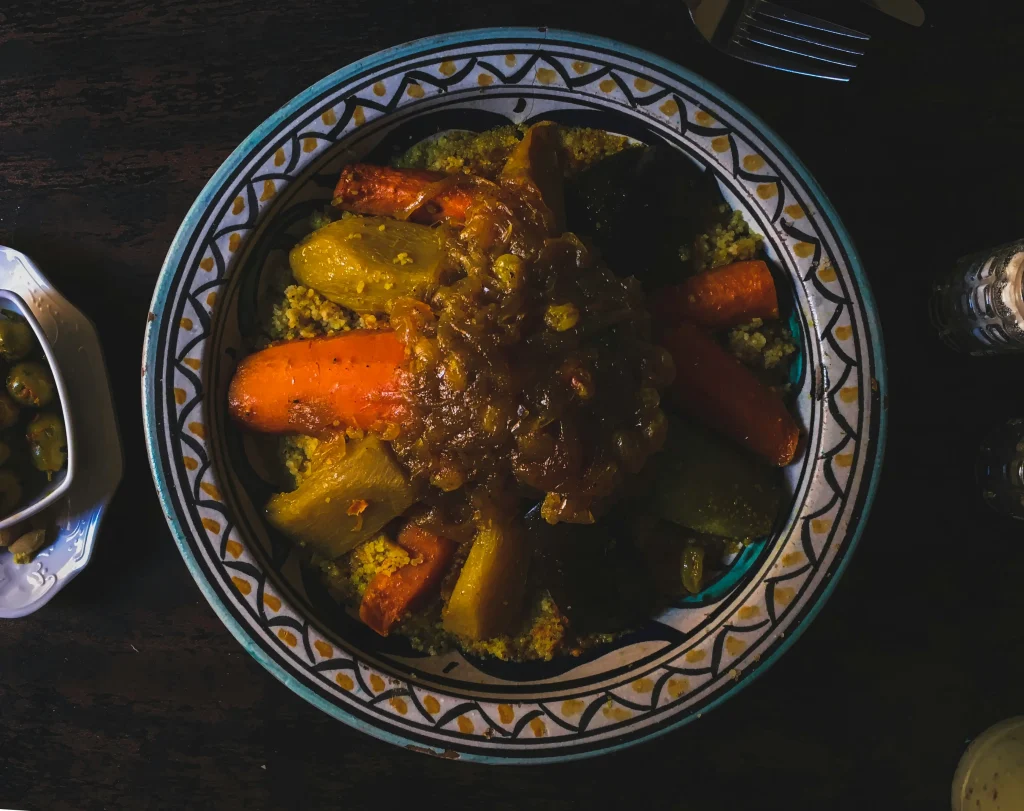
Every Friday, Moroccan families gather to enjoy couscous, and it’s a tradition you’ll find in almost every Moroccan restaurant. The couscous is steamed to perfection and served with a hearty vegetable stew, often including carrots, zucchini, chickpeas, and raisins. The addition of tfaya, caramelized onions with cinnamon and sugar, elevates this dish from simple to spectacular.
Couscous is comfort food in its purest form, and the communal way it’s shared only adds to its magic.
Pastilla: Sweet and Savory Delight
If you’ve never tried pastilla, prepare to be amazed. This dish is a true Moroccan paradox: it’s a pastry that’s both sweet and savory. Traditionally made with pigeon (though chicken is often used), almonds, and spices like cinnamon, pastilla is wrapped in thin layers of warqa dough and baked until golden and crispy. Once it’s out of the oven, it’s dusted with powdered sugar, creating an irresistible contrast between the rich, savory filling and the sweet top layer.
It’s an elegant dish that shows off the culinary ingenuity of Morocco—perfectly balancing flavors and textures in every bite.
Harira Soup: A Ramadan Favorite
When Ramadan rolls around, harira becomes the star of the table. This rich, tomato-based soup is packed with lentils, chickpeas, and a blend of spices like ginger and turmeric. It’s traditionally eaten to break the fast during Ramadan, often accompanied by chebakia, a honey-drenched sesame cookie. But you don’t need to wait for Ramadan to enjoy this hearty soup; it’s a staple in Moroccan cuisine, and it’s perfect for any time of the year.
“Harira is not just a soup, it’s a comfort in a bowl.”
Check out this guide for more Moroccan food & drinks here
What to Expect When Dining at a Moroccan Restaurant
Now that you know about the food, let’s talk about the experience of dining at a Moroccan restaurant. It’s not just about the meal itself—it’s about immersing yourself in the entire atmosphere.
Decor: A Feast for the Eyes
As soon as you step into a Moroccan restaurant, you’re transported into a different world. The décor is an explosion of color, with intricate zellige tiles, plush cushions, and brass lanterns that cast a warm, golden glow. The space feels cozy and inviting, with every detail designed to make you feel at home. It’s like stepping into a living, breathing piece of Moroccan art.
The Art of Moroccan Tea Service
If you’re lucky enough to visit a traditional Moroccan restaurant, you’ll be treated to the art of mint tea. Served in delicate glasses, the tea is poured from a great height, creating a frothy top. It’s not just about the tea itself—it’s about the ceremony. The pouring, the delicate glassware, the sweet aroma of mint—everything about the tea service is designed to make you feel like royalty.
Live Music and Entertainment
Moroccan restaurants often feature live music, creating a lively atmosphere that enhances the overall experience. You might hear Gnawa music, a spiritual form of music that’s deeply tied to Moroccan culture. The rhythms and melodies will transport you even further into the heart of Morocco, making the experience even more unforgettable.
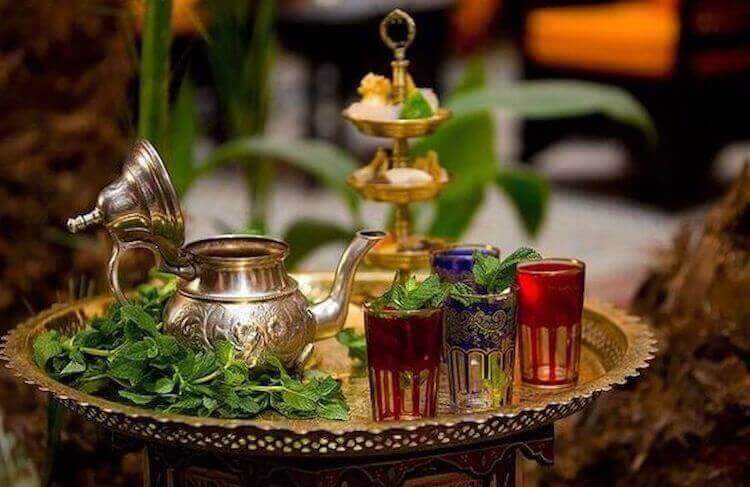
FAQs About Moroccan Restaurants
1. Is Moroccan food spicy?
Not typically “hot” spicy, but Moroccan cuisine is certainly full of rich spices that make each dish flavorful. The spices are more about depth and warmth—think cinnamon, cumin, saffron, and ginger rather than fiery chilies.
2. What should I wear to a Moroccan restaurant?
Moroccan restaurants often have a relaxed yet stylish vibe. Smart-casual attire is recommended, but some upscale spots may ask for more elegant clothing. Think comfortable yet fashionable—a nice shirt and pants or a flowy dress for women should do the trick!
3. Can I find vegetarian options easily?
Yes, absolutely! Morocco is full of flavorful vegetarian dishes. Couscous, tagine, and various salads (like zaalouk, a smoky eggplant salad) are staples that can be found in most Moroccan restaurants. Whether you’re vegan, vegetarian, or just looking to cut back on meat, there’s plenty of food to enjoy.
4. How long does a traditional Moroccan meal last?
Moroccan meals are meant to be savored. Expect a leisurely 2+ hours for a full traditional meal. Meals are an experience, not a rush. It’s about sitting back, enjoying conversation, and savoring every bite. Don’t be in a hurry—this is part of the Moroccan way of life.
5. Are Moroccan restaurants kid-friendly?
Most Moroccan restaurants are very family-friendly. The culture of sharing dishes makes it easy to find something for everyone, and the casual, communal dining style means kids will feel at ease. Many places even offer child-friendly options, like simpler stews or couscous with vegetables.
6. What kind of drinks should I pair with Moroccan food?
If you enjoy wine, Moroccan wines are a surprising treat! The country has a rich wine-making tradition, and you can pair a bottle of red or white with your meal for a unique experience. If you prefer non-alcoholic beverages, freshly squeezed juices, mint tea, or smoothies are perfect to complement the flavors of your meal.
7. Can I expect live music or entertainment at Moroccan restaurants?
Many Moroccan restaurants embrace the lively spirit of the country, with live music often being a part of the experience. You may hear Gnawa music, a deep and soulful genre of Moroccan music, or even enjoy a performance of Andalusian melodies. It’s all about creating a vibrant and festive atmosphere that complements the rich flavors of the food.
8. What’s the best way to enjoy Moroccan tea?
Moroccan mint tea is a ritual in itself. It’s typically served in small glasses, often with a generous amount of sugar. The tea is poured from a height to create a frothy surface, and it’s meant to be enjoyed slowly, in the company of friends or family. To experience it properly, sip the tea in small sips and savor the minty sweetness.
9. How can I find the best Moroccan restaurants?
Look for a few key signs of authenticity—restaurants that offer a wide selection of traditional dishes, serve food family-style, and have a cozy, welcoming atmosphere. You might also check reviews or ask locals for recommendations. One of the best ways to experience Morocco’s true culinary scene is by booking a food tour with The Moroccan Tours, where you’ll be led by expert guides to the best hidden gems.
10. Are Moroccan restaurants expensive?
While you can certainly find upscale, fine-dining options in Morocco, there are also plenty of affordable and casual eateries serving delicious meals. The key is to look for places where the locals dine, as these tend to offer the best value for money. Prices will vary depending on the restaurant’s location and level of service, but overall, Moroccan food can be incredibly affordable.
11. Is tipping customary in Moroccan restaurants?
Yes, tipping is generally appreciated in Morocco. While service charges may already be included, it’s customary to leave a tip of around 10% in most restaurants. For small cafés or street vendors, rounding up your bill is a nice gesture.
If you’re ready to take your Moroccan culinary adventure to the next level, there’s no better way than with The Moroccan Tours. These expertly guided tours will allow you to explore Morocco’s rich culture, vibrant markets, and most importantly, its amazing food.
Whether you’re wandering the spice-scented souks of Marrakech or enjoying a traditional dinner in a hidden riad, The Moroccan Tours offers a range of experiences tailored to all tastes. With knowledgeable guides who share stories of the history behind every dish, you’ll gain an insider’s perspective on Morocco’s culinary treasures.

Why choose The Moroccan Tours?
- Authentic Experiences: Explore local food markets, taste traditional dishes, and even join hands-on cooking classes.
- Expert Guides: Immerse yourself in Morocco’s culture with the help of experienced, passionate guides who know the ins and outs of local cuisine.
- Customizable Tours: Whether you’re a food lover, history buff, or someone who loves a good adventure, The Moroccan Tours offers customized itineraries to meet your interests.
- Culinary Delights: From street food to high-end dining, The Moroccan Tours ensures you taste Morocco’s culinary diversity in the best possible way.
By booking a tour with The Moroccan Tours, you can feel confident that you’re getting a genuine, deep dive into the flavors and culture of Morocco. Plus, they make the experience incredibly easy and stress-free!
Contact us now!!!!!
A Final Thought: Why Moroccan Restaurants Should Be on Your Bucket List
Dining at a Moroccan restaurant is more than just a meal; it’s a journey. It’s a journey through history, through culture, and through the incredible flavors that have been passed down through generations. Every dish tells a story, every bite brings you closer to understanding Morocco’s rich and diverse heritage.
So, the next time you find yourself in a Moroccan restaurant, take a moment to savor the experience. Close your eyes, take a deep breath, and let the spices, the warmth, and the hospitality sweep you off your feet.
“A meal at a Moroccan restaurant is an invitation to experience the world with your senses.”
In a world where food is often rushed, Moroccan restaurants offer a rare opportunity to slow down, savor, and celebrate. Ready to dive into the magic of Moroccan cuisine? Your tastebuds—and your heart—are in for a treat.
SEO Titles:
- Moroccan Restaurant: A Culinary Adventure Awaits You
- Moroccan Restaurant Secrets: Explore Exotic Flavors Today
- Experience Authentic Moroccan Restaurant Dining Bliss
SEO Title: Moroccan Restaurant Experience Awaits with Exquisite Flavors
Slug: moroccan-restaurant-experience
Meta Description:
Keyphrase Synonyms: Moroccan dining, Moroccan eateries, Moroccan food spots, Moroccan restaurants, authentic Moroccan cuisine, Moroccan dining experiences
Featured Image Alt Texts, Description, and Title:
- Alt Text: “Moroccan Restaurant dining table with traditional dishes” Description: A beautifully set dining table at a Moroccan restaurant featuring a traditional tagine, couscous, and fresh herbs. The warm ambiance adds to the authentic experience. Title: “Moroccan Restaurant Dining Table with Traditional Dishes”
- Alt Text: “Moroccan restaurant interior with lantern lighting” Description: A Moroccan restaurant interior showcasing ornate lanterns, cozy seating, and vibrant colors that make dining a sensory experience. Title: “Moroccan Restaurant Interior with Lantern Lighting”
- Alt Text: “Mint tea served in Moroccan restaurant glasses” Description: Refreshing Moroccan mint tea served in intricately designed glasses at a Moroccan restaurant, a must-try beverage for any visitor. Title: “Moroccan Restaurant Mint Tea Served in Glasses”
Post Image Alts, Descriptions, Captions, and Titles:
- Alt Text: “Moroccan chef preparing tagine in restaurant kitchen” Description: A chef at a Moroccan restaurant prepares a classic tagine, the slow-cooked dish that defines Moroccan cuisine. Caption: “Watch as the chef prepares a traditional Moroccan tagine in the restaurant kitchen.” Title: “Moroccan Chef Preparing Tagine in Restaurant Kitchen”
- Alt Text: “Traditional Moroccan couscous served with vegetables” Description: A beautifully plated Moroccan couscous with vegetables, served family-style at a Moroccan restaurant. Caption: “Couscous served with a delicious mix of vegetables—perfect for a hearty Moroccan meal.” Title: “Traditional Moroccan Couscous with Vegetables”
- Alt Text: “Moroccan street food vendor serving freshly cooked food” Description: A local vendor serves delicious Moroccan street food in a vibrant, bustling market, capturing the essence of Moroccan cuisine. Caption: “Street food vendors bring authentic Moroccan flavors to life in the heart of the city.” Title: “Moroccan Street Food Vendor Serving Freshly Cooked Food”
- Alt Text: “Live music performance at a Moroccan restaurant” Description: Guests enjoy a live music performance with traditional Gnawa and Andalusian melodies at a Moroccan restaurant. Caption: “The sounds of live Moroccan music set the perfect mood for dining.” Title: “Live Music Performance at Moroccan Restaurant”
- Alt Text: “Moroccan dessert platter with baklava and pastries” Description: A tempting platter of Moroccan desserts, including baklava and other traditional pastries, served after a delicious meal. Caption: “Indulge in traditional Moroccan desserts to complete your meal.” Title: “Moroccan Dessert Platter with Baklava and Pastries”


